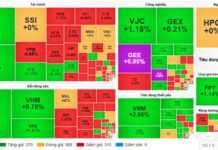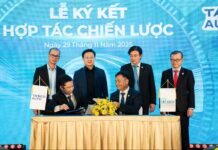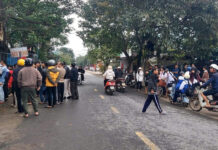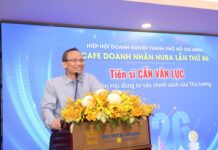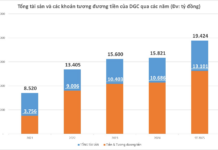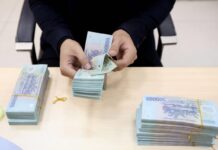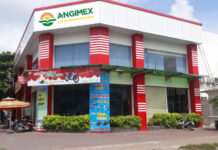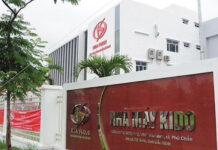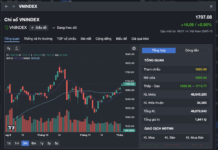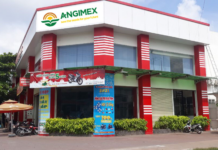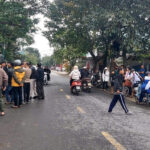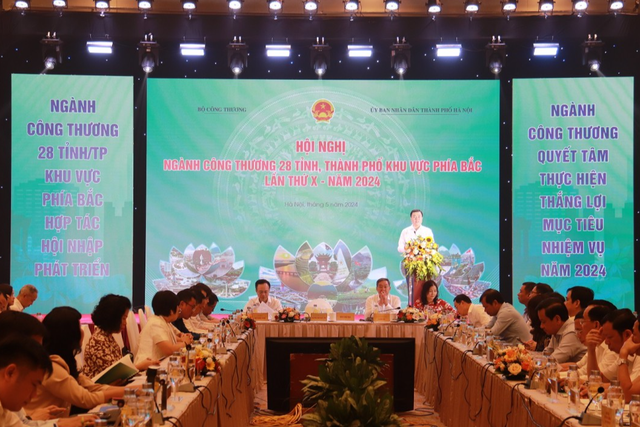
The 10th Conference of the Industry and Trade Sector of 28 Northern Provinces and Cities in 2024. Photo: VGP/PT
This information was shared by Ms. Tran Thi Phuong Lan, Acting Director of Hanoi Department of Industry and Trade, at the 10th Conference of the Industry and Trade Sector of 28 Northern Provinces and Cities in 2024, held today, May 17.
According to the Ministry of Industry and Trade, despite the challenging context for economic development, the industrial production of 28 localities in the Northern region has seen positive changes and maintained a fairly high growth rate in the first four months of 2024.
25 localities with positive IIP growth
25 out of 28 localities recorded positive growth in the industrial production index (IIP) compared to the same period last year; 11 out of 28 localities achieved a growth rate of 10% or higher. Some northern industrial centers have regained their industrial growth momentum, including Thai Nguyen, Quang Ninh, Bac Giang, Hai Phong, and Hanoi.
In parallel with industry, domestic and foreign trade in the region also achieved remarkable results, with the total retail sales of goods and services revenue of the 28 northern provinces and cities estimated at VND 1,404 thousand billion, up 12.3% over the same period.
The region’s total export turnover reached USD 120.7 billion, up 18.3% over the same period. 24 out of 28 localities in the region recorded positive export growth. The localities with high export turnover and a large proportion in the region all achieved high growth compared to the same period: Hai Phong reached USD 16 billion, accounting for 13.3%, up 21%; Thai Nguyen reached USD 17.8 billion, accounting for 14.7%, up 34%; Bac Giang reached USD 16.5 billion, accounting for 13.7%, up 22%…
Still ‘hesitant’ in developing green industry
Contributing her opinion at the conference, Ms. Tran Thi Phuong Lan, Acting Director of Hanoi Department of Industry and Trade, stated that the industry and construction sector maintained its growth momentum and made important contributions to Hanoi’s overall growth. The manufacturing industry played a crucial role, maintaining a proportion of about 87% in the structure of the city’s entire industry.
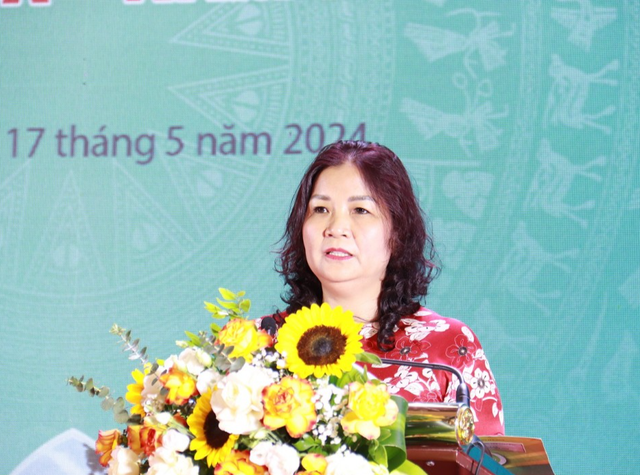
Ms. Tran Thi Phuong Lan, Acting Director of Hanoi Department of Industry and Trade. Photo: Cong Thuong Newspaper
However, according to Ms. Lan, the development of a priority industry program, the establishment of smart factories, and the development of green industry in some localities are still hesitant and have not been effectively implemented. The progress of technical infrastructure investment in industrial clusters in some provinces and cities is slow, and attracting new investment remains challenging. Some projects have been licensed to invest in industrial parks and clusters but have not been implemented or have started construction but are not yet operational.
“The linkage and connectivity among regions, especially among adjacent provinces and cities, to develop synchronously the fields of industrial infrastructure planning, trade, energy, and logistics, remain limited. We have not established a cooperation mechanism for development among members in the region,” said Ms. Tran Thi Phuong Lan.
Mr. Nguyen Van Thanh, Director of Hai Phong Department of Industry and Trade, pointed out that the laws related to industrial cluster management are still overlapping and contradictory, and many issues arising in practice are not covered by regulations. The procedures for establishing industrial clusters remain challenging due to the conflicting provisions of the law on investment and the law on industrial cluster management and development.
On the other hand, some industrial clusters formed before Decision No. 105/2009/QD-TTg do not have investors, leading to limitations in environmental protection. Some industrial clusters lack wastewater treatment systems as required, and the quality of public utilities and amenities in the clusters is generally low.
To achieve the goal of industrial cluster development according to the planning of Hai Phong City, Mr. Nguyen Van Thanh suggested that the Ministry of Industry and Trade soon submit to the Government for consideration and promulgation of the Law on Key Industries, the Law on Industry Support, and the issuance of a circular guiding Decree No. 32/2024/ND-CP dated March 15, 2024, of the Government on the management and development of industrial clusters.
There should be a mechanism to support industrial clusters that cannot be transferred to enterprises for infrastructure completion and cluster maintenance…
Meanwhile, to promote import and export activities, the representative of Lang Son Province proposed that the competent authorities focus on investing in the logistics service industry in the area and upgrading the border belt roads, roads to the border gates, and roads to the border gates in the province to connect transportation, contributing to improving competitiveness and developing logistics services; attracting investment to upgrade border gate infrastructure, focusing on key border gates that are of interest to the Chinese side, such as Huu Nghi-Huu Nghi Quan international border gate…
Proposals to clarify regulations on gasoline business
Proposing to the conference, the Departments of Industry and Trade of Hai Duong and Quang Ninh provinces suggested that the Ministry of Industry and Trade advise the Government to amend and supplement Decree 83/2014/ND-CP and Decree 95/2021/ND-CP on gasoline business in the direction of allowing agents to buy from multiple sources to avoid supply disruptions, increase healthy competition in business, and ensure the rights of agents and consumers;
At the same time, the two Departments of Industry and Trade also proposed that the Ministry of Industry and Trade remove the regulation on logos and only stipulate the signage of traders at the store; Consider stipulating that the trader in charge is responsible for calculating, balancing, and proposing wholesale prices, retail prices, and discount rates for the entire distribution system – registering the selling price and the time of application with the Ministry of Industry and Trade and the Ministry of Finance according to the Law on Prices.
In response to this proposal, the Ministry of Industry and Trade said that it has developed a draft new decree on the gasoline business, replacing the Government’s Decree No. 83/2014/ND-CP on the gasoline business and the decrees amending and supplementing Decree No. 83/2014/ND-CP, to be sent to relevant organizations and individuals for comments.
“The above proposal of the Department of Industry and Trade of Hai Duong Province will be studied, received, and explained by the decree drafting committee before submission,” said the Ministry of Industry and Trade.
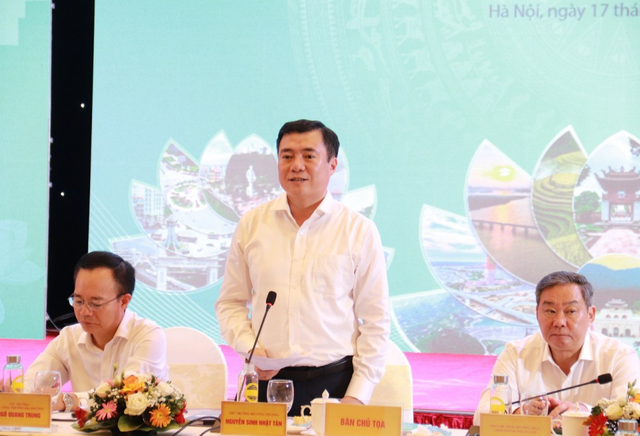
Mr. Nguyen Sinh Nhat Tan, Deputy Minister of Industry and Trade – Photo: Cong Thuong Newspaper
Limited regional linkage
Despite the positive results, the leadership of the Ministry of Industry and Trade acknowledged that the industry and trade sector in the northern region still has certain limitations. Some provinces and cities have not met the assigned targets, with some indicators showing negative growth (industry and import-export). The development of a priority industry program, the establishment of smart factories, and the development of green industry in some localities are still hesitant and have not been effectively implemented.
The commercial infrastructure system has been invested in, but overall, some provinces are still backward, lacking synchronization, and lacking connectivity to meet development requirements. There is a lack of large-scale wholesale markets and commodity distribution centers.
Linkages and connections among regions, especially among adjacent provinces and cities, to develop synchronously the fields of industrial infrastructure planning, trade, energy, and logistics, remain limited. The policies of the localities also differ, and the coordination and linkage are not regular and lack depth. There is a lack of cooperation mechanisms for development among members in the region, which has a significant impact on the development of the industry and trade sector in the region and the country.
The coordination of trade promotion activities, investment promotion, trade fairs, and product exhibitions among localities in the region has not been conducted regularly and effectively. The field of e-commerce has not developed evenly across localities, especially in mountainous areas…
Prevent recurrence of supply shortages
To overcome the above limitations, Deputy Minister of Industry and Trade Nguyen Sinh Nhat Tan proposed that localities, especially the Departments of Industry and Trade, focus on implementing some key contents, including:
Localities should closely follow the Government’s directions, especially the tasks assigned in Resolution No. 01/NQ-CP and Resolution No. 02/NQ-CP dated January 5, 2024, of the Government, and the Action Program of the Industry and Trade Sector to implement Resolution No. 01/NQ-CP. Pay attention to the compatibility and synchronization between national, regional, and provincial planning.
Localities should focus on implementing the Proposal for Restructuring the Industry and Trade Sector for the period from now to 2030, with a vision to 2045, to create new momentum and space for local development.
“Actively provide raw materials for production activities, reducing dependence on imported sources. Pay attention to ensuring the supply of gasoline and electricity for production and daily life with the motto ‘In any case, do not let supply disruptions happen’. The Ministry of Industry and Trade is determined not to let the shortage of supply recur,” said the Deputy Minister.
Regarding the National Power Development Planning for the period of 2021-2030, with a vision to 2050, and the plan for implementing the planning, Deputy Minister Tan proposed that localities in the region coordinate in implementing, including developing the power system in border and island areas, striving for 100% electricity coverage in remote and mountainous areas. At the same time, strongly promote energy-saving movements as this factor is closely related to the industrial production sector.
Regarding other activities related to commercial infrastructure, import and export in border areas… as proposed by localities, the Deputy Minister affirmed that the Ministry of Industry and Trade listens and receives the proposals and will study and guide the handling. Regarding administrative procedures, the Ministry of Industry and Trade will continue to promote administrative reform and create favorable conditions for production and business for enterprises.
Finally, the Deputy Minister proposed that localities focus on combating counterfeit, fake, and poor-quality goods on both traditional and e-commerce channels.

